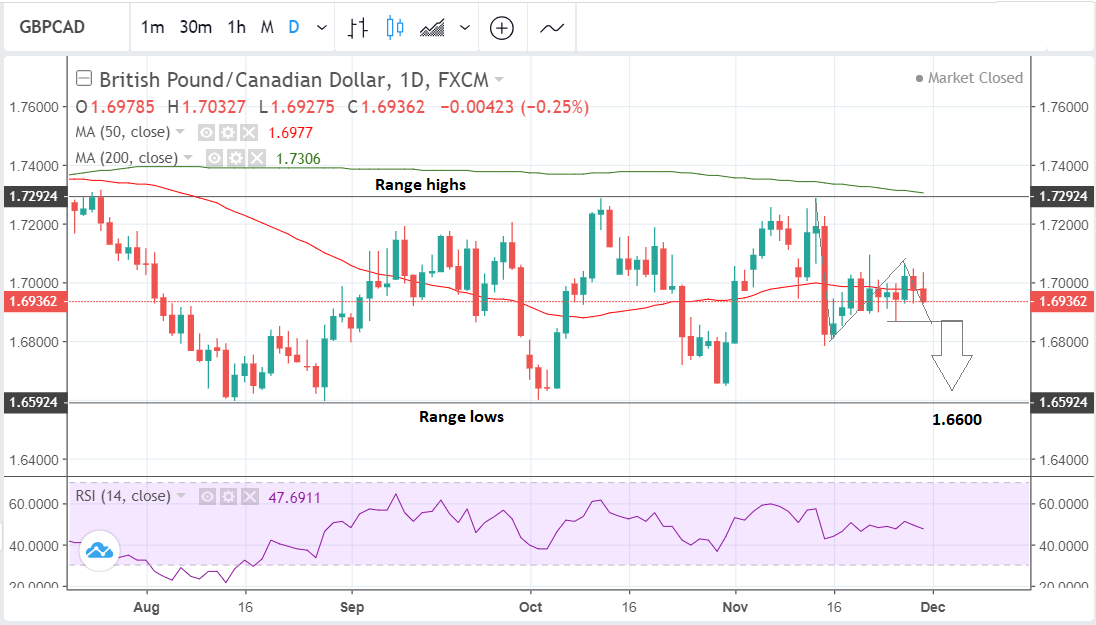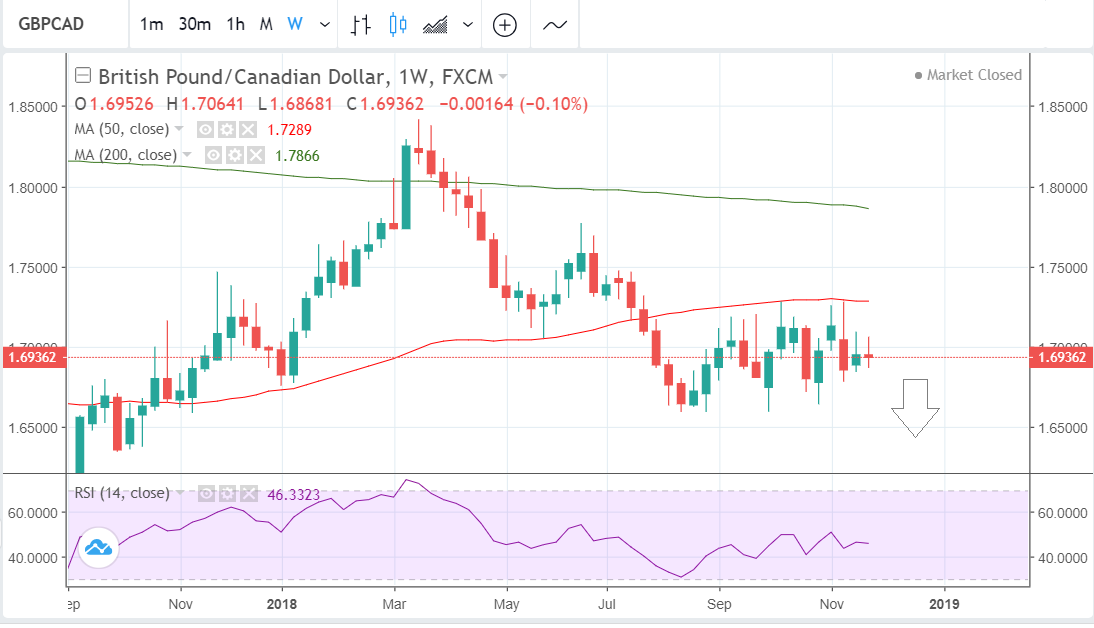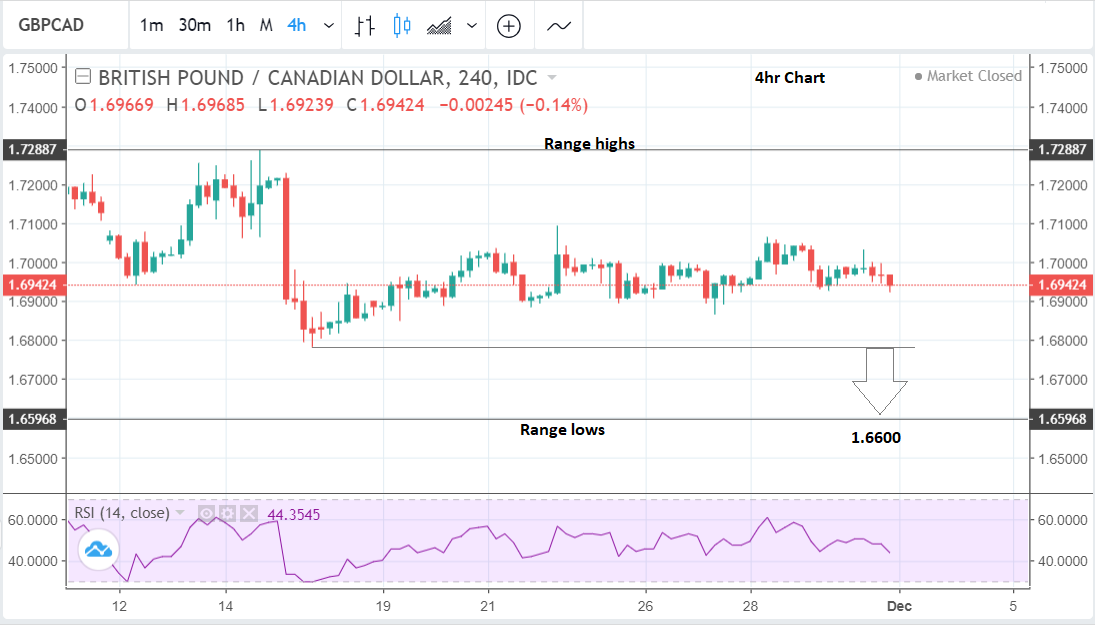The Pound-to-Canadian-Dollar Rate in the Week Ahead: Bottom of the Range in Sight

Image © Pavel Ignatov, Adobe Stock
- GBP/CAD to decline toward bottom of range.
- Next target of 1.66 will test the range floor.
- GBP eyes Brexit headlines, CAD looks to BoC.
The Pound-to-Canadian Dollar rate continues trading in the middle of a range but will retain a bearish bias in the week ahead.
The pair has traded in a wide range spanning the gap between 1.66 and 1.73 during recent months, although it looks more fitting for the next move to be an extension down to the 1.66 low than back up towards the highs.

Above: Pound-to-Canadian-Dollar rate shown at daily intervals.
Brexit uncertainty and volatility in the oil market have been the pair's biggest drivers of late, with oil weakness capping the Canadian Dollar and politics weighing on Sterling.
The weekly chart shows the pair falling in a bear trend since striking its March 2018 highs. Repeated attempts to break above the 50-week moving average have failed and the market remains biased to the downside.

Above: Pound-to-Canadian-Dollar rate shown at weekly intervals.
The four-hour chart shows how the 1.68 lows are key. We see them as a line in the sand that must be broken to confirm the next move lower is under way.
It looks more 'right’ for the sideways move to resolve in a leg lower rather than higher. We forecast a break below 1.68 will eventually confirm a new leg down to a target of 1.66.

Above: Pound-to-Canadian-Dollar rate shown at 4-hour intervals.
Advertisement
Bank-beating exchange rates. Get up to 5% more foreign exchange by using a specialist provider to get closer to the real market rate and avoid the gaping spreads charged by your bank when providing currency. Learn more here
The Canadian Dollar: What to Watch
The Canadian Dollar could gain support from the trade truce brokered by President’s Trump and Xi at the G20 summit over the weekend. This would also be in line with the bearish technicals outlined above.
The main fundamental event for the Canadian Dollar this week is the Bank of Canada (BOC) interest rate announcement on Wednesday at 15.00 GMT. The BOC last raised its interest rate in October so few see it taking any action in December.
Higher interest rates drive up currencies by attracting and retaining foreign capital. Although this means the Loonie is unlikely to be boosted by the BoC this week, it could still be affected by the Bank’s statement, which might contain clues about future interest rate moves.
“We look for the Bank of Canada (BoC) to remain on hold next week after raising rates 25 bps at its October meeting. Although we look for rates to remain unchanged at its upcoming meeting, we also look for the BoC to continue to tighten policy roughly in line with the Federal Reserve’s rate hike trajectory,” says a note to clients from Wells Fargo, whose economists forecast three rate hikes from the BoC in 2019.
October's trade balance data due Thursday at 13:30 is another key release on the calendar, which is expected to reveal a deeper deficit for the recent month. The deficit is forecast to have widened to $-0.7bn from $-0.4bn previously.
The Ivey PMI measures Canadian business sentiment and is forecast to fall to 60.3 in November, from 61.8 previously, when it is released at 15.50 on Thursday. Any result above 60 is considered extremely strong.
Canadian employment data is expected to show an overall rise of 11.2k employees when released at 13.30 on Friday. The unemployment rate is forecast to stay at 5.8%, with part-time jobs falling -22.6k.
Given the Canadian Dollar's sensitivity to oil the OPEC meeting on Thursday could also be a big day for the currency, especially since many analysts are forecasting a cut in production to support oil prices.
Advertisement
Bank-beating exchange rates. Get up to 5% more foreign exchange by using a specialist provider to get closer to the real market rate and avoid the gaping spreads charged by your bank when providing currency. Learn more here
The Pound: What to Watch
Brexit politics will probably dominate the Pound in the coming week as Theresa May tries to woo as many MPs as possible to vote for her withdrawal deal.
As things stand, however, it looks increasingly unlikely she will be successful and there is significant uncertainty as to what will happen following the defeat with a number of potential scenarios likely to play out.
The uncertainty is likely to ensure Sterling trades recent ranges with traders unwilling to take a big directional punt on the currency until such a time as they know what the future EU-UK relationship will look like.
At the weekend Sam Gyimah, the Science and Universities minister, became the latest member of May’s government to resign after saying leaving the EU risked the UK’s interests being “repeatedly and permanently hammered,” and that the UK was at risk of losing ‘its voice its vote and its veto’.
Gyimah appeared to endorse a second referendum in his resignation note on facebook, saying, “we shouldn’t dismiss out of hand the idea of asking the people again what future they want, as we all now have a better understanding of the potential paths before us”. His voice added to the growing number now calling for a second referendum.
Prime Minister May only has a majority of 5 seats in Parliament including her DUP allies who number 10 and all of them have said they will vote against her deal because it leaves Northern Ireland vulnerable to being treated differently to the rest of the British Isles.
Further opponents include 'brexiteer' rebels and 'remainers' from with her own party. Labour and other opposition MPs will also be encouraged to vote against her by their party whips.
This leaves the most likely outcome of the December 11 vote a defeat for the government. Experts say this would be most likely followed by either a general election or a second referendum, both causing further uncertainty, and probably keeping Sterling pressured.
On the 'hard' data front, the main releases for the Pound in the coming week are the three Purchasing Manager Index (PMI) surveys for November.
The first PMI to be released is Manufacturing, on Monday, at 9.30 GMT. It is forecast to show a recovery to 51.5 from 51.1 previously.
Construction PMI is out on Tuesday at the same time and is expected to show a fall to 52.6 from 53.2 in the previous month.
Services PMI - the more important of the three - is released on Wednesday and is forecast to rise to 52.5 from 52.2 previously.
PMI’s are often used by economists as a leading indicator of economic growth as the results often signal changes taking place in the broader economy before they are revealed in hard data such as GDP.
A result of over 50 signals an expanding economy whilst below 50 contraction.
Another key event in the week ahead is a speech from Mark Carney the governor of the Bank of England (BOE) on Tuesday at 9.15. This is followed by a speech from BOE’s Vlieghe on Tuesday at 18.00, and Haldane at 18.00 on Monday. Recently the bank released a worst case scenario of how Brexit would impact on the economy.
New car sales in November are set to be released at 9.00 on Wednesday and are considered a positive barometer of wealth creation.
Advertisement
Bank-beating exchange rates. Get up to 5% more foreign exchange by using a specialist provider to get closer to the real market rate and avoid the gaping spreads charged by your bank when providing currency. Learn more here




